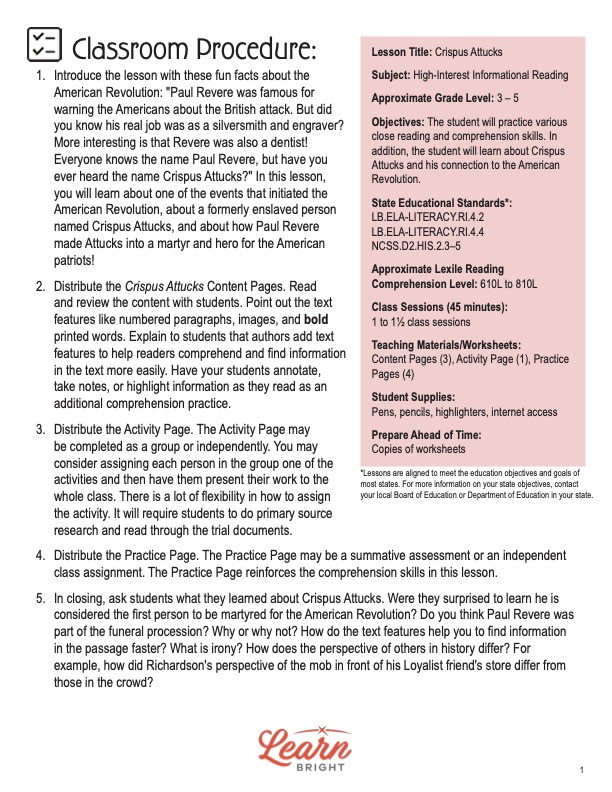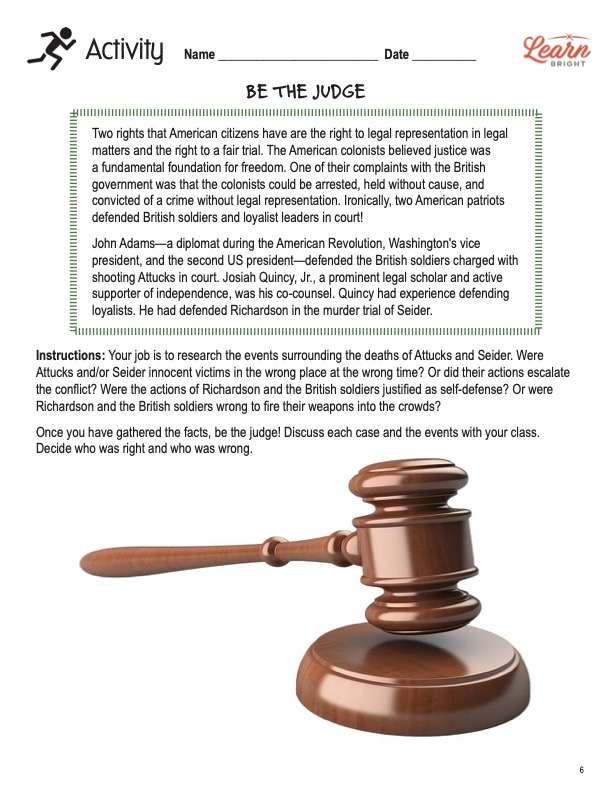Description
What our Crispus Attucks lesson plan includes
Lesson Objectives and Overview: Crispus Attucks is a high-interest reading comprehension lesson plan. As such, students will practice various close reading and comprehension skills. In addition, they will learn about this incredible woman and her contributions to our history. This lesson is for students in 3rd grade, 4th grade, and 5th grade.
Classroom Procedure
Every lesson plan provides you with a classroom procedure page that outlines a step-by-step guide to follow. You do not have to follow the guide exactly. The guide helps you organize the lesson and details when to hand out worksheets. It also lists information in the yellow box that you might find useful. You will find the lesson objectives, state standards, and number of class sessions the lesson should take to complete in this area. In addition, it describes the supplies you will need as well as what and how you need to prepare beforehand. Make sure your students have internet access for the activity.
Teacher Notes
The paragraph on this page gives you a little more information on the lesson overall and describes what you may want to focus your teaching on. It explains that you can teach this lesson in a whole-class setting or as an independent, small-group activity. The blank lines are available for you to write out any thoughts or ideas you have as you prepare.
CRISPUS ATTUCKS LESSON PLAN CONTENT PAGES
Setting the Scene
The Crispus Attucks lesson plan contains three content pages. Starting out, the lesson provides some context to help students understand what happened to Crispus Attucks that made him a notable historical figure. It was a cold evening in March of 1770. The streets of Boston were filled with colonists aimlessly ambling around the shops and taverns on King Street.
British soldiers intermingled with the crowd. They were wary and on high alert. Tensions in Boston were running high. Just a few weeks earlier, an 11-year-old boy named Christopher Seider had been killed when a mob of young patriot boys vandalized a store owned by a loyalist.
This mob had pelted the windows of a small shop with rocks, taunted shoppers, and blocked the store’s entrance. They held a large sign in front, trying to draw attention to the owner’s persistent support of the British. A customs agent named Ebenezer Richardson attempted to remove the sign and disperse the crowd. News reports from that day say the crowd turned on Richardson, throwing rocks and sticks while chasing him to his home across the street. Richardson barricaded the door and shouldered a musket.
Meanwhile, the mob grew more violent at the store. The store owner, a loyalist named Theophilus Lillie, feared for his and his family’s lives. Store glass was shattering around him. A stone hit Lillie’s wife, and the crowd became more out of control. Something has to be done to help my friend, Richardson thought as he watched. Richardson grabbed his musket and filled it with gunpowder. From his home across the street, he fired a rifle shot in the direction of the crowd.
The Death of Christopher Seider
The first shot was blank and harmless as Richardson tried to scare off the crowd, thinking the noise from his musket would do the trick. The shot proved ineffective, and the crowd became increasingly more riotous. Richardson believed his and his friend’s lives were in jeopardy now. He reloaded the musket with gunpowder and, this time, with musket ball pellets. Richardson took aim, cocked the hammer, and pulled the trigger. Eleven-year-old Christopher Seider was struck in the arm and chest. Seider did not survive the night. The news further infuriated the mob.
Later, with tensions still running high, Seider’s funeral procession drew a reported crowd of nearly 2,000 people. Sam Adams, who would later become a prominent figure in the Revolutionary War, was a respected community leader and arranged the funeral. Historians think another future Revolutionary War hero, Paul Revere, joined the procession as well. Revere was a little older than Seider and lived nearby. Beginning at the Liberty Tree, the procession wound down the streets of Boston, led by boys around Seider’s age. Seider was buried in the Granary Burying Ground.
Crispus Attucks
Fast forward to March 5, 1770. Since Seider’s burial, minor skirmishes, fights, and several incidences of vandalism of British loyalists’ homes and businesses were on the rise. There was a noticeable increase in British soldiers on the streets. Their bright red coats stood out in the otherwise plainly attired crowds. Rumors of a revolution abounded. With each uptick of violence came more troops and seemingly more violence. One man, Crispus Attucks, found himself in the center of the action. His life would end by nightfall.
Attucks was described as a tall, muscular man of African and Wampanoag tribe descent. His father was an enslaved African living somewhere near Framingham, Massachusetts. Attucks was born sometime around 1723. He remained a slave until he escaped at age 27 and moved to the Boston area. He worked on a whaling ship, one of the few employment opportunities offered to non-white men at the time. As one might imagine, it was a hazardous occupation.
According to some accounts, Attucks was in a tavern with fellow sailors. A British soldier walked in and asked the tavern keeper about a part-time job at the port. Because British soldiers were underpaid, many sought work at the port to load sailing ships to make extra money. At the time, there was a lot of tension between the Americans and the British over jobs.
The labor market in Boston was tight, jobs were difficult to find, and the competition was high. American colonists believed the British were taking jobs away from them and that this added competition and depressed wages. Needless to say, the soldier’s inquiry was not well received.
Boston Massacre
After overhearing the conversation between the British soldier and the tavern keeper, Attucks became outraged. He had already fought with another British soldier earlier in the week. Unafraid of another altercation, he and the other sailors angrily confronted the soldier. The conversation got very heated. According to witness reports, the British soldier quickly fled from the tavern because he was outnumbered and feared the interaction would become violent.
Later that evening, Attucks led a group of 30 to 50 men and confronted a group of British soldiers in front of the Custom House. Accounts vary as to who started the fracas. Some say a British soldier struck a colonist, which started the fight. Other witnesses reported that the fight started because a crowd threw snowballs at and taunted the soldiers. Then, according to various accounts, Attucks attempted to hit a British army captain with a stick.
Instead, he hit a soldier in the head, knocking his rifle from his hands. Attucks grabbed the soldier’s bayonet, screaming to the mob, “Kill the dogs, knock them over!” The soldier retrieved his rifle and shot Attucks; the first shot caused damage but did not deter Attucks from the attack. The second musket ball, however, left an inch-wide hole in Attucks’s chest, resulting in his death.
As more citizens arrived, the situation got out of control. In the confusion, and despite orders not to, British soldiers began firing into the crowd to scatter them and regain control. Attucks and two of his maritime brethren were killed. Eight others were seriously injured, two of which later died from their wounds.
Paul Revere’s Memorial
Crispus Attucks is now memorialized as the first martyred hero of the American Revolution. Why? As an escaped enslaved person, Attucks risked his freedom if someone caught him. Ironically, a fugitive of enslavement was the first to give his life in the pursuit of freedom and liberty.
Paul Revere coined the term the “Bloody Massacre” (later referred to as the Boston Massacre) when he created an engraving of the event. The image quickly circulated among the colonies and fueled the fire to declare independence from Great Britain. Attucks became a well-known martyred hero in the fight for independence and a symbol of freedom for all Americans.
CRISPUS ATTUCKS LESSON PLAN WORKSHEETS
The Crispus Attucks lesson plan includes two worksheets: an activity worksheet and a practice worksheet. Each one will help students solidify their grasp of the material they learned throughout the lesson. You can refer to the classroom procedure guidelines to know when to hand out each worksheet.
BE THE JUDGE ACTIVITY WORKSHEET
For the activity, students will play the role of judge and decide who was right and who was wrong in the cases of Christopher Seider and Crispus Attucks. Were Attucks and/or Seider innocent victims in the wrong place at the wrong time? Or did their actions escalate the conflict? Were the actions of Richardson and the British soldiers justified as self-defense? Or were Richardson and the British soldiers wrong to fire their weapons into the crowds? Students will gather the facts and discuss each case with their class
CRISPUS ATTUCKS REVIEW PRACTICE WORKSHEET
The practice worksheet requires students to answer a series of 10 questions. These questions all relate to the content pages, so students will need to refer to them often for the answers. In addition, each question provides which reading tool the question corresponds to, such as text feature, vocabulary, or comprehension.
Worksheet Answer Keys
At the end of the lesson plan document is an answer key for the practice worksheet. The correct answers are all in red to make it easier for you to compare them with students’ responses. Given the nature of some of the prompts, there may be some variation in student answers. If you choose to administer the lesson pages to your students via PDF, you will need to save a new file that omits these pages. Otherwise, you can simply print out the applicable pages and keep these as reference for yourself when grading assignments.









